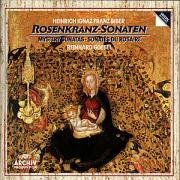| All Artists: Heinrich Ignaz Franz von Biber, Reinhard Goebel, Musica Antiqua Köln, Phoebe Carrai, Andreas Holschneider, Konrad Junghänel Title: Biber: Mystery Sonatas (Rosenkranz-Sonaten or Rosary Sonatas) - Goebel Members Wishing: 1 Total Copies: 0 Label: Archiv / Universal Int'l Release Date: 7/8/1991 Album Type: Import Genre: Classical Styles: Chamber Music, Historical Periods, Baroque (c.1600-1750), Classical (c.1770-1830), Instruments, Strings Number of Discs: 2 SwapaCD Credits: 2 UPC: 028943165624 |
Search - Heinrich Ignaz Franz von Biber, Reinhard Goebel, Musica Antiqua Köln :: Biber: Mystery Sonatas (Rosenkranz-Sonaten or Rosary Sonatas) - Goebel
 | Heinrich Ignaz Franz von Biber, Reinhard Goebel, Musica Antiqua Köln Biber: Mystery Sonatas (Rosenkranz-Sonaten or Rosary Sonatas) - Goebel Genre: Classical
|
Larger Image |
CD Details |
CD ReviewsFirst class performance of strange and difficult music S. Gustafson | New Albany, IN USA | 07/04/2001 (5 out of 5 stars) "Reinhard Goebel and members of the Musica Antiqua Köln give an almost effortless and very listenable performance of Heinrich Ignatz Franz von Biber's Mystery Sonatas here. This is no mean feat, in that each of these sonatas save the first, and the final Passacaglia, is in a different and weird -scordatura- tuning. This means that the violin strings are tuned very unconventionally. The musical notation is in tablature, basically telling the violinist where to put his fingers, and how the instrument should be tuned for this piece. In effect, the violin is turned into several different instruments, and each tuning presents the player with a new and unknown landscape. In No. 11, "Resurrexit Christus Hodie," the two central strings actually are switched, so that the tones of the unstopped strings jump up and down rather than going from lowest to highest. With this deliberate weirdness, you might fear that the results would be unmusical. This fortunately is not so. These are emotion-filled works from the seventeenth century baroque, usually dated to 1678. The sonatas track the meditations on the life and passion of Christ as presented in the Roman Catholic Rosary devotion, and as such are rich in expressive, occasionally even violent, musical ideas. Despite their technical difficulty, Reinhard Goebel succeeds in making them sing." Beautiful compositions, performance and sound Alan Lekan | Boulder, CO | 11/26/2005 (5 out of 5 stars) "Biber's so-called "Mystery Sonatas" are among the most alluring, meditative, virtuostic and amazingly beautiful compositions ever written for the violin - which this fine recording captures most vividly. Three aspects of this recording stand out as superb and make this CD a highly recommended recording for Biber's "Mystery Sonatas." The first is the extremely vivid and crystaline sound quality from DG, who created an ideally-resonant sound ambiance that brings out the mystery and depth of this music. Stunning. The second aspect is the most unique, mysterious and musically innovative compositions from the Austrian violin virtuoso and composer, Biber. The depth of emotive effects and degree of virtusosity immediately catch the attention of the listener and draws one into their mysteries (of the life of Christ). In addition to the "standard" harpsichord and/or therebo continuo, these sonatas also add deeply-resonant organ bass pedal-points that create a powerful and alluring backdrop for the drama of the solosit to unfold. Several reviews below give some valuable background info on these compositions if you are not familiar. The last aspect that makes this recording special is the accomplished playing of Reinhard Goebels that is of the highest caliber. His technique in the 32nd-note passages is flawless, crisp and worthy of the finest accolades while the sensitive and soaring tonality he exudes in the slower movements is extremely attractive and never grating to the ear. Goebels plays this music not only with the utmost virtuosity but also with a well-judged passion - bringing drama while respecting Biber's sacred and meditative musical intentions by not overly "attacking" the music. His smooth lyricism honors Biber's contemplative designs. Personally, I prefer Goebel's artistry and tone in these works compared to Holloway or Manze, but the fine continuo playing from Romanesca adds to the allure of that recording (Harmoni Mundi). So, the combination of these three aspects along with some interesting notes from Goebels on the music and scordatura techniques make this a most desirable and recommended recording from Musica Antiqua Koln. I cannot say there are any "dull moments" or uninspired playing or composing anywhere on the entire 2 CD's - only the most skillfully and mysteriously composed music for violin and Baroque continuo. It remains one of the more unique compositions and an ever-fascinating study of the art of violin playing. And Musica Antique Koln honors this sacred music with the highest art and musical sensitivity. 5 stars for sure." A great performance of very unusual music Juan Pablo Pira | Guatemala, Guatemala Guatemala | 07/27/2001 (5 out of 5 stars) "Biber wrote each of the 15 Rosary sonatas and the final passacaglia in different scordature (16 different scordature!!). To make things even more difficult, the sonatas were scored for violin and B.C. so, except for the bass line, all parts for the other instruments were either composed or improvised by the performers. Rather than just providing accompaniments, the members of Musica Antiqua Koeln show their amazing musicality by realizing one of the most beautiful performances of baroque music you can find."
|

 Track Listings (8) - Disc #1
Track Listings (8) - Disc #1